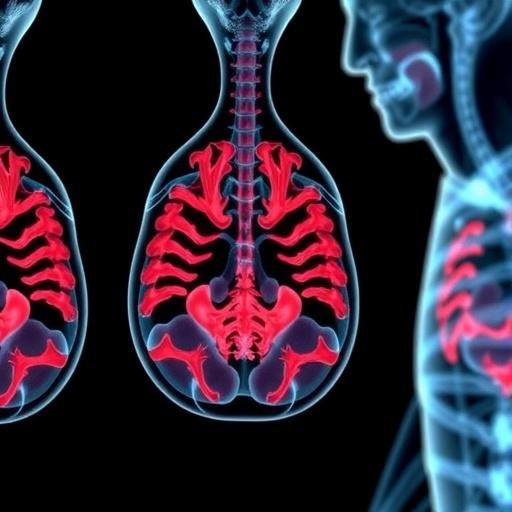
A groundbreaking study published in the renowned journal BMC Cancer has shed new light on the significant impact of sarcopenia—a condition characterized by the progressive loss of muscle mass and strength—on mortality outcomes in cancer patients. By meticulously analyzing a large cohort of over a thousand cancer patients, researchers have elucidated how sarcopenia not only exacerbates the risk of death from all causes but also specifically heightens the likelihood of cancer-related mortality. This research marks a critical advancement in oncology, unveiling the prognostic significance of muscle deterioration in cancer trajectories.
Sarcopenia, traditionally studied in the context of aging populations, has now been firmly implicated as a vital clinical concern in oncology. The study harnessed data from the National Health and Nutrition Examination Survey (NHANES), focusing on cancer patients diagnosed between 1999 and 2014. These patients’ data allowed for a comprehensive evaluation of the links between muscular decline and survival rates over extended follow-up periods. Importantly, the researchers sought to transcend basic observational studies by developing sophisticated survival prediction models, intended to project patient outcomes over three and five years.
Central to the study’s methodological rigor was the use of advanced statistical techniques combined with cutting-edge machine learning. The team first applied the Least Absolute Shrinkage and Selection Operator (LASSO) Cox regression to selectively identify predictive features from the extensive dataset, ensuring the final model only incorporated the most impactful variables. This method optimizes the balance between model complexity and predictive power. With these features identified, multivariable Cox regression analyses were conducted to quantify sarcopenia’s independent effects on mortality risks.
The results were both striking and clinically relevant: sarcopenia increased the hazard of all-cause death by approximately 33%, while the risk of dying specifically from cancer rose by 67%. These findings underscore sarcopenia’s role not merely as a comorbidity but as a potent prognostic factor intricately linked to cancer patient survival. The elevation in hazard ratios suggests that muscle wasting may contribute to mechanisms that directly or indirectly worsen patient outcomes, possibly through diminished functional reserve or impaired responses to cancer therapies.
Building upon these epidemiological insights, the researchers developed and validated five machine learning algorithms—Support Vector Machine, Logistic Regression, Random Forest, LightGBM, and XGBoost—to predict individual survival outcomes. Among these, the Light Gradient Boosting Machine (LightGBM) algorithm stood out, demonstrating superior predictive performance for both three-year and five-year survival estimates. This algorithm’s ability to handle complex, high-dimensional data with remarkable efficiency made it invaluable for modeling the nuanced relationships between sarcopenia and mortality.
The strength of the LightGBM-based survival model was further substantiated through decision curve analysis and Kaplan–Meier survival plots. These analyses affirmed that the model could effectively distinguish patients at high risk of mortality from those with better prognoses. Such risk stratification holds immense potential for personalized oncology, enabling clinicians to identify vulnerable patients who might benefit from intensified monitoring or targeted interventions aimed at mitigating sarcopenia.
The implications of this research extend far beyond prognostication. By elucidating the tangible risks associated with muscle loss in cancer, the study paves the way for integrating sarcopenia assessment into routine clinical practice. Interventional strategies, such as nutritional support and resistance training, could be prioritized for patients identified as sarcopenic, potentially improving treatment tolerance and survival outcomes. Moreover, these findings encourage a paradigm shift towards multidisciplinary approaches that address not only tumor biology but also the systemic condition of the patient.
From a technological standpoint, the integration of machine learning into survival prediction models represents a transformative leap in precision medicine. Unlike traditional regression models, machine learning algorithms can adapt to complex, nonlinear interactions within clinical data, offering more accurate and individualized predictions. The successful application of LightGBM in this study exemplifies how harnessing artificial intelligence can refine patient risk assessments in oncology, inspiring future research to build upon and expand these models with larger datasets and additional clinical parameters.
The study’s reliance on NHANES data, widely regarded for its robustness and representative sampling, adds to the credibility and generalizability of its findings. However, the researchers acknowledge potential limitations, including the retrospective nature of the analysis and the need for external validation in more diverse populations. Future studies are thus warranted to confirm these results and explore causative pathways linking sarcopenia to cancer progression and mortality.
Importantly, this research highlights an often-overlooked aspect of cancer care: the importance of maintaining muscle health amid complex oncological treatments. Sarcopenia may not only reflect the catabolic effects of cancer and its treatments but could also exacerbate vulnerabilities by impairing physical function, immune competence, and metabolic resilience. Addressing sarcopenia, therefore, offers a dual benefit of improving both quality of life and survival prospects.
The personalized survival prediction model developed through this work holds promise as a critical tool in clinical decision-making. By accurately identifying patients at elevated risk of mortality within specific timeframes, oncologists can tailor treatment intensity, follow-up frequency, and supportive care referrals accordingly. This precision approach aligns with the broader movement towards individualized medicine, where therapeutic strategies are dynamically adapted based on patient-specific risk profiles.
Furthermore, the success of the LightGBM model demonstrates the utility of gradient boosting frameworks in biomedical applications. Their capacity for handling large feature sets and capturing complex interdependencies makes them ideally suited for multifactorial diseases such as cancer. With continuing advances in computational power and data availability, such machine learning tools are poised to revolutionize prognostic modeling across diverse medical fields.
The findings also stimulate a reconsideration of standard clinical assessments, suggesting that routine evaluation of muscle mass and function should be incorporated into cancer patient workups. Biomarkers of sarcopenia, whether imaging-based or biochemical, could serve as accessible indicators of prognosis, facilitating early intervention. In parallel, research into the biological mechanisms underpinning sarcopenia’s effect on cancer outcomes could unveil novel therapeutic targets.
Ultimately, this pioneering study offers a compelling narrative on how integrating clinical observations with advanced analytic methodologies can unravel complex prognostic puzzles in oncology. By highlighting sarcopenia as a modifiable risk factor for mortality, it opens avenues for improving cancer survival through holistic and personalized patient management. As the oncology community embraces these insights, the convergence of clinical science and artificial intelligence promises a brighter horizon for patient care.
Subject of Research:
Association between sarcopenia and mortality in cancer patients; development of survival prediction models using machine learning.
Article Title:
Association of sarcopenia with all-cause and cause-specific mortality in cancer patients: development and validation of a 3-year and 5-year survival prediction model.
Article References:
Cui, F., Dang, X., Peng, D. et al. Association of sarcopenia with all-cause and cause-specific mortality in cancer patients: development and validation of a 3-year and 5-year survival prediction model. BMC Cancer 25, 919 (2025). https://doi.org/10.1186/s12885-025-14303-9
Image Credits: Scienmag.com
DOI:
https://doi.org/10.1186/s12885-025-14303-9
Tags: advanced statistical techniques in oncologyaging and sarcopenia relationshipcancer patient outcomescancer survival prediction modelscomprehensive evaluation of cancer prognosisimpact of muscle deterioration on healthmachine learning in cancer researchmortality risk factors in cancermuscle loss in cancer patientsNHANES cancer data analysisprognostic significance of sarcopeniasarcopenia cancer mortality


